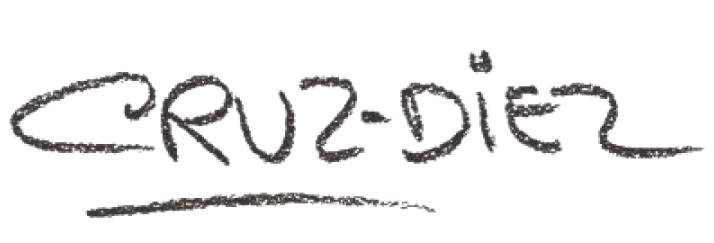Dancing Among Cruz-Diez
(16.03.2011)
By the end of January the beautiful MFAH-adjacent crosswalks had been re-painted. It was an exciting ride home from work, mainly because I have been waiting for this exhibit since last year!
I visited the museum a couple of weeks ago, and since then I've been meaning to write a little bit about Carlos Cruz-Diez, the exhibit and the impressively rich, yet underestimated modern art of Venezuela. But life gets the best of us sometimes, so it took a couple of weeks and a second and third visit to the exhibit to finally be able to digest it all and hit the keyboard. The exhibit I speak of? MFAH's definitive retrospective Carlos Cruz-Diez: Color in Space and Time featuring over 150 works spanning all the way from the 40's until now.
The narrative of Venezuelan modernism, and specifically that of Venezuelan Geometric Abstraction and Kineticism, is generally told through the works of a few influential Paris-based artists who broke through the deep-rooted figurative artistic traditions of the country. In 1959 Cruz-Diez conceived of his first Physicromie pulling from his observations and experiences with the phenomena of color and its physical qualities, on which his subsequent experimentations with color, movement and experience are based upon (1). This deep sense of experimentation, its basis in scientific precedent, and a detachment from the inward looking expressionist styles has become one of the mainly contended and criticized aspects of, not just Cruz-Diez’s art, but of the kinetic art movement in Venezuela.
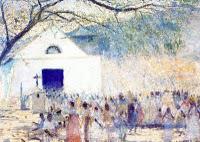 |
| Armando Reverón, Cruz de Mayo, 1948 |
At the turn of the 20th century, the first oil wells were discovered in Venezuela. These circumstances naturally created a drastic change in the economy of the country, as well as a rapid migratory phenomenon that occurs when large amounts of population begin to move to the city from the agricultural outskirts of the country. Marta Traba characterizes the drastic change as resulting in a sort of instant urban center, this being the burgeoning city of Caracas. By the 1950’s Venezuela is producing millions of tons of oil barrels a year, a number that is incomparable to that of other exporters like Mexico. Taking advantage of the new affluence, Caracas began purchasing art from Europe, and creating an almost equally instant cultural framework for the city (2). This cultural framework begins to be characterized by artists like Calder, Vasarely, and Kandinsky, whose artistic influence begins a wave of anti-figurative movements within a country which has had a long tradition of figurative art through the 19th Century; artists like, Armando Reverón, Luis Malaussena, and Pedro Centeno Vallenilla had been the major exponents of Venezuelan art, and whose work can be closely compared to Diego Rivera and Jose Obregon.
This historical background sets up the framework in which Carlos Cruz-Diez emerges with his first studies of color, namely the Physicromies. As Mayhall observes in her essay, the emergence of geometric abstraction and Modernist art altogether, in Venezuela are due to outer influences completely detached from any kind of national identity with the Modernist styles (3). Traba, on the one hand, confirms the large amount of European art import, but does point out that beginning with Alejandro Otero in the 30’s, and followed by Jesus Soto in the 40’s, the undercurrent of the Venezuelan Avant-Garde was already heading towards geometric abstraction and kineticism (2). Departing from this premise that Traba proposes, Cruz-Diez’s art arrives as part of that lineage of Venezuelan artists that were trained both in Venezuela and Paris, and had begun rejecting academic or traditional representational techniques of space, time, form, and color.
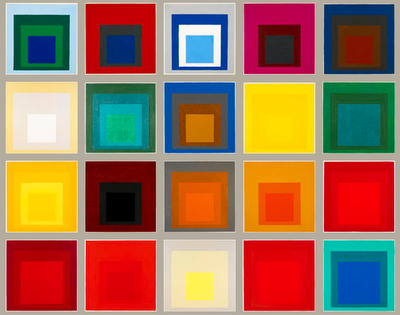 |
| Josef Albers, Homage to The Square, late 40's - 60's |
A generation of European artist that included Victor Vasarely and Josef Albers, whose works are pivotal points in the studies done by Cruz-Diez. Specifically Albers’ series titled Homage to The Square, in which he utilizes concentric squares as a standard composition on which to explore different color combinations. The series was Albers’ venture into “relating pure colors, on to another, unencumbered by extraneous visual material” (4), in an attempt to release color from representational forms. In this attempt to free color from subjects found in nature, the use of the square is fitting, because it begins to present color as a field and not as a form, the square loses its physical properties and it becomes part of the discourse of the interaction between color surfaces, how they alter each other and the issues of perception that these studies bring to surface (5). Victor Vasarely moves even closer to the essence of Kineticism. He criticizes the vestiges of figuration that still remain in the first waves of abstraction—read: artists like Picasso, whose whose cubist works never let go of the figurative tradition—for him, movement is forever linked to spatial illusion, colors and forms are the two elements integral to any composition (6). Of his investigations in black and white, Frank Popper writes, “reflect this preoccupation with wave vibrations,” or what is called ‘virtual movement.’ Taking Bora III as an example—a piece that juxtaposes black and white vertical stripes, creating vibrations between layers of concentric squares and the variation of the stripes’ sizes—the artist is exploring two-dimensional graphic elements in order to create a work that forces itself upon the viewer and creates movement and vibrations (6).
In order to truly challenge tradition, is not enough to pull from immediate contemporaries. Cruz-Diez traces his influences as far back as impressionism, specifically to Monet’s interest in coloration, and in doing finds a rot from which to ground his experiments (5). The impressionists’ work was concerned with the phenomena of movement and of color, dealing with the so-called “direct retinal impression” (6), which allowed them to deal with scenes in an objective way. Notwithstanding, Monet’s or Degas’ studies on color, light, and movement were done within the parameters of traditional figurative representation, whereas artists like Jesus Rafael Soto and Vasarely were beginning to set themselves apart from that framework of representation. This is where Cruz-Diez’s experiments in finding a way to represent the event of color outside of convention begins to coincide with scientific experiments and studies, which will allow him to get to the realization of the Physichromies. Departing from studies of Newton’s experiments with white light, Cruz-Diez then moved on to Dr. Lang’s proposal on additive color and the possibilities of producing a full spectrum of chromatic range by using only a few colors (6). The artist also looked at the experiment on light interference and trichromatic color vision by Thomas Young, and Heimholtz’ studies on the three cone receptors found in the retina. As well as Maxwell’s 1860 experiments and Ducos de Hauron’s ideas on additive and subtractive synthesis for creating full color images. These studies done between 1954 and 1959, explains the artist, “not only refer to color, but to perception, light and its inevitable relationship with space” (5), all concepts on which the Physichromies are based upon.
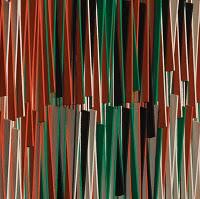 |
| Carlos Cruz-Diez, Physichromie #24, 1961 |
The Physichromies were the first major series of works completed by Carlos Cruz-Diez, in which the artist begins to put forth his theories. Cruz-Diez is no longer representing the house, the tree, or the car as we have been taught to represent it. For him, depicting reality was not to be found behind the symbols that we have been traditionally conditioned to use, whether we are referring to figurative style or even the purely expressionist gestures of those artists in search of the soul’s expression (7). The Physichromies, in turn become a conscious exercise in the use of color as a phenomenon, as a changing natural variation that is never the same. The artist describes the series as
light traps, a space where a series of color strips interact and transform one another, moreover, the movement of the viewer and the light source create a series of chromatic variations, similar to those produced in a real landscape with each evolution of the sun – Cruz-Diez (5)
Jose Antonio Navarrete writes of the work of Carlos Cruz-Diez in his article On The Eventfulness of Color. He speaks mainly of the Physicromies, which depart from the principle that "color is not just a means for representation but it can also be a “construction of perception affected by eventual relationships” (1). These works call for the viewer to actively participate in the process of making the artwork; color becomes an event, an element that is acted upon by changing light and the eye. This investigation in experiential art, one calling for an audience to “complete the work,” leads Cruz-Diez to the series that followed the Physicromies, called Chromosaturation Chambers, which connect the artist to a long heritage of Venezuelan artists who in the 50’s where working towards an integration of art and architecture (1). Navarrete’s definition of the Physichromies deeply parallels the artist’s own definition of the series. Cruz-Diez is adamant in defining them as light traps, “a space where a series of color strips interact and transform one another” (5), he also gives incredible importance to the role the movement of the viewer and changing light play in the process of experiencing a Physichromie.
The spirit of what Hugo Achugar termed as “glocal,” defined as “Lo glocal—la conjunction de lo global y lo local, ” it is a term that results from the conjunction of the global and local, and manifests not just in its etymology a sense that modernism in Latin America was something deeper than the pure detachment from the known forms (8) can be exemplified specifically through one of Jesus Soto’s early photographic series. Titled La Margarita (1952), it explains an approach in which a photograph of a fishing net becomes both universally detached from locality whilst still being a document of a specific moment in time and place (8). Herein is where the experimentations of Cruz-Diez finds its place within the narrative of Venezuelan Modernism, as the eagerness of a country, coming out of a restricting dictatorship that had for long oppressed any type of innovation in the cultural landscape, grasped onto Kineticism as their chosen identity to leap into the modern cultural scene.
 |
| Carlos Cruz-Diez, Projects for a Mural, 1954-1965 |
Though I would consider myself a fairly seasoned Cruz-Diez audience, I ended up being pleasantly surprised by the showing of the artist's early work. The early figurative and traditional landscapes set up a particularly appropriate background for what is to become one of the most extensive abstract experimentations in color, space and movement. Quickly the museum walls are filed with geometric and color experimentations of the like we see in art and design schools. Studies on vibration, composition and movements on the flat surface of the canvas, gimmicky pieces featuring objects projecting from the wall and sculptures that feature pleasant variations of Calder's signature. Quickly though, the first Physicromie appeared. And I don't mean the first in the exhibit, I mean Physicromie #1. From there the museum gallery becomes a dance floor for the interested art onlookers who walk two steps ahead, four steps back, and swing from one side to the next, and back again. The seemingly endless series of Physicromies along the museum walls invite us to move around and experience the effects of color in space.
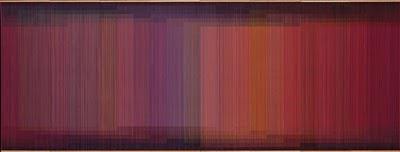 |
| Carlos Cruz-Diez, Physicromie #500, 1970 |
The Chromosaturation Camber–part of a series that began as transparent rooms outside of the Paris Metro, and are now a multi-room labyrinth spaces flooded with fluorescent colors and geometric shapes that disappear into space–and the room for the Sensory Experience of Color are the two experiential moments that take use beyond what any Physicromie will ever be able to. And they are both brilliant in doing just that.
The one unfortunate thing about the whole thing is the attempt at showing 3-D photographs of the Atelier. An otherwise excellent touch to end the exhibit by showing us where and how the artist works, is a bit dampered by the sad gimmick of making the large-scale photographs have some sort of three-dimensional effect that only detracts from the whole situation, and would have frankfly done better without.
Otherwhise, and without an ounce of sentimentality, the exhibit managed to transport me back to childhood days spent jumping around Otero sculptures at the park, and driving by the numerous Physicromies placed all over my hometown city in Venezuela. Which is quite remarkable and more than anything I could ever ask of from an exhibit.
MFAH presents Carlos Cruz-Diez: Color in Space and Time. On view through July 4th, 2011.
Cited Sources:
(1) Navarrete, Jose Antonio. “Carlos Cruz-Diez: Or The Eventfulness of Color.” Art Nexus 2009: n. Print.
(2) Traba, Marta. Arte Latinoamericano Actual. Caracas: Universidad Central de Venezuela, 1972. Web. 27 Mar. 2010.
---. Dos Decadas Vulnerables en Las Artes Plasticas Latinoamericanas (1950-1970). Mexico: Siglo Veintiuno, 1973. Print.
---. “Finale: Allegro Con Fuoco. CinОticos y Experimentadores.” Alfredo Boulton y Sus Contemporaneos : DiЗLogos Criticos en el Arte Venezolano, 1912-1974. Ed. Ariel JimОnez. New York, Caracas: Museum of Modern Art;FundaciЧn Cisneros Caracas, 2009. 278-284. Print.
(3) Mayhall, MArguerite. “Modernist bu Not Exceptional: The Debate Over Modern Art and National Identity in 1950s Venezuela.” Latin American Perspectives 32.2 (2005): 124-146. Print.
(4) Sherwin Garland, Patricia. “Josef Albers: His Paintings, Their Materials, Technique, and Treatment.” Journal of the American Institute for Conservation 22.2: 62-67. Print.
(5) Cruz-Diez, Carlos. Carlos Cruz-Diez : color happens. Madrid: Fundacion Juan March, 2009. Print.
---“My Aesthetic Is The Effectiveness Of The Evidence.” Carlos Cruz-Diez : color happens. Madrid: Fundacion Juan March, 2009. Print.
(6) Popper, Frank. Origins and Development of Kinetic Art. New York: New York Graphic Society, 1968. Print.
(7) Alfredo Boulton. “Color and The History of Painting.” Readings in Latin American modern art.
(8)Achugar, Hugo. “Modernidades Latinoamericanas.” Alfredo Boulton y Sus Contemporaneos : Dialogos Criticos en el Arte Venezolano, 1912-1974. Ed. Ariel JimОnez. New York, Caracas: Museum of Modern Art; Fundación Cisneros Caracas, 2009. 14-27. Print.
Images via MFAH, Flkr, BOMB mag, Por 12 Metros De Cultura, Albers Foundation, Bluementhal Inc., 
Source : Artfully Yours - María Gabriela Orán
